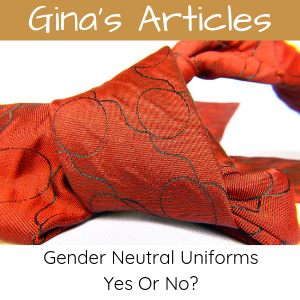Should skirts be banned in schools?
The BBC asked me to comment on a Bradford based school’s decision to ban skirts and introduce a gender neutral school uniform.
Gender In The Workplace
Before we start, let’s not assume this gender neutral uniform debate is just for schools.
This is a conversation that needs to happen in workplaces across the world too.
Both schools and workplaces should be open, inclusive and tolerant environments where everyone can be proud of and celebrate their Authentic Selves. A safe space where you can bring ALL of who you are to work and school. No hiding, no masks. Showing up as the real and true you.
What Is Gender?
Gender is traditionally seen as a binary – meaning there are 2 genders. Boy and girl. Our gender is assigned to us at birth; “It’s a boy!”
Most people think gender is about your physical body. But that isn’t the case.
Gender identity is how you feel about yourself. It is how you feel on the inside. This can be different from the sex you were assigned at birth.
Gender expression is how you present your gender identity to the world – through your individual preferences, how you look, how you wear your hair and your clothes. It is about your demeanour, your voice and the way you speak. It is about your mannerisms and movements.
Gender In Society
As parents, when you know if you have a boy or a girl, you can apply the rules assigned to that gender. For instance: through the clothes they wear, the way they are taught to behave in public and what role they will go on to play in society. You have gender norms that can be enforced and ‘guidelines’ to follow on how to socialise your child in society.
Your child’s gender identity is typically decided FOR them based on societal norms and the people surrounding them. Collectively, we tell the child what they are and how they should be.
The label boy or girl is very restrictive – when forming your identity, socially, culturally, politically etc. It dictates how you show up in the world and what can be possible for you.
I was taught to be a girl because that is the sex I was assigned at birth. I was taught how to be a girl in public: reserved, not speak up and to walk a certain way. I was given pinafores and dresses to wear. Pink toys: Barbie Dolls, My Little Ponies and Winnie The Pooh. And I was encouraged to play with the girls in class.
From an early age, I remember not being totally comfortable with being labelled a girl. I rejected the dolls, pink was a DEFINITE no go and dresses? Oh my word. You have no idea what a struggle that was.
I preferred playing outside with my brothers. Riding my bike, playing in the stream at the bottom of the garden and playing hide and seek, dressed as a tomboy.
Yet, there was always this pressure when I was in the public eye or at social engagements to have my hair a certain length and style, to present myself as a femme adult and to tone down my mannerisms and natural movements. To conform to the societal expectations of being ‘a girl.’
Gender As A Spectrum
I prefer to see gender on a spectrum, where our sense of gender exists somewhere between male and female.
That is how I experience my gender identity. And I know thousands of others that do too.
Gender neutral means neither male or female.
Why Is Having A Gender Neutral Uniform Important?
When the gender neutral debate comes up, it is often thought it is for trans and non-binary inclusion purposes only.
I disagree with that.
It is inclusive to a wide range of people.
Yes – lesbians, gay men, those that identify as bisexual and intersex are able to express themselves more freely.
BUT it also allows ANYONE that doesn’t feel comfortable in the ‘dress code’ that is associated with their sex assigned at birth to be their authentic self.
When I was at school and in a few jobs I have had, it was compulsory to wear a skirt. I felt incredibly uncomfortable and it affected me mentally. I was unable to bring all of who I was to what I was doing because I felt so awkward, so out of place and I lost my sense of self. I was too busy in my head trying to come to some sort of peace about what I was subjected to wear, against my will, to be educated and to do my job to the best of my ability.
Having a gender neutral uniform enables people to express themselves fully, without any pressures to be or look a certain way. It gives a sense of freedom and liberation and creativity. A gender neutral uniform allows everyone to feel comfortable and not be confined by outdated gendered norms.
I have always been gender non-conforming. I didn’t attend any formal events at school, such as dinners or the end of year Prom because it was expected that I wear a dress. NO WAY.
If I had shown up in my trouser suit, I would have ostracised myself from my classmates even further. Getting the attention of a boy whilst wearing a trouser suit, can you imagine? Because I wouldn’t want to ‘out’ myself by looking at the girls… So many elements to unpack here.
Even today. Wearing a suit and tie on public transport as a woman is very challenging. The looks, the comments, the side glances, the hushed conversations under hands. I find that rude, first and foremost. Secondly, I find it odd. When I was at school I had to wear a tie. Adults didn’t give me a second look when I was in my school uniform. Yet get me on a train today wearing a suit and tie (looking very dapper) sitting opposite a man in a suit and tie. Pfff. You can imagine.
Why Is There Such A Heated Debate?
Good question.
There are a few points to address here.
- Some are using the gender neutral uniform to ‘eliminate the short skirt’ issue. These are two very separate aspects. One – dealing with inappropriately short skirts. Two – a much larger discussion around inclusion. To mention the elimination of short skirts and introducing a gender neutral uniform as the solution is mixing the two conversations and giving a warped perspective to the wider population about gender neutral issues. The two matters need to be separated out.
- What about boys? If you ban skirts, and introduce trousers for the girls, what about the boys? They may want to wear skirts but are now not able to. That isn’t being inclusive. Forgetting any social constraints they may feel. I will come back to this point.
- And what about the girls that want to wear skirts. But you ban them for everyone. What about them? That isn’t inclusive either.
- Some people see this as LGBT+ inclusion gone mad. What people aren’t seeing here is this isn’t only for the LGBT+ kids to feel included. Non-LGBT+ kids don’t feel comfortable in skirts too. It also has practical issues such as restricting movement and denying participation in sport in the playground.
- Banning skirts versus choice. Inclusion is about being given a choice. Not to take away choice and to restrict even further. Every student should feel they have freedom of choice. Allowing all elements of the uniform to be worn by any student regardless of gender is the way forward.
What Is The Real Issue Here?
There is something going on underneath the surface that people aren’t saying.
The real issue that needs to be addressed is this.
An environment and culture needs to be cultivated where everyone can feel safe to wear what they want to wear.
Inclusion is bringing all of who you are, to work and to school. With no censoring, no hiding and no pretending to be someone else.
My experience at high school. We could wear either skirts or trousers. Some days I wanted to wear a skirt (on very few days) but I predominantly wore trousers.
Social pressures, peer pressure and wanting to fit in meant I never did wear a skirt. I didn’t feel the environment was one where I could feel comfortable to make that change for the day. I saw others dressing differently for the day and the bullying/inappropriate behaviour that took place as a result of it. I can’t imagine what a boy would have experienced from his peers if he chose to wear a skirt for a day.
We are conditioned from a young age about what is ‘right’ and what is ‘wrong’. What we should and shouldn’t wear dependent on whether we are male or female. And then there is the way that people get used to seeing you dress and present yourself a certain way, creating a fixed identity that cannot be broken easily. And lastly, what our choices of clothing means to others. A boy dressed in a skirt means…? They are gay? They are trans? They are a drag queen? We make judgements instantly about someone based on what they are wearing.
Summary
Let’s give our children and adults in the workplace choices to wear skirts, shorts, trousers or any other variation that feels good to them, irrespective of their gender. More choice. Less restriction.
AND most importantly, work on the culture of the environment so everyone feels safe and supported to wear what they want, without shame, criticism, judgement or bullying.
Create that environment and you have nailed inclusion.


